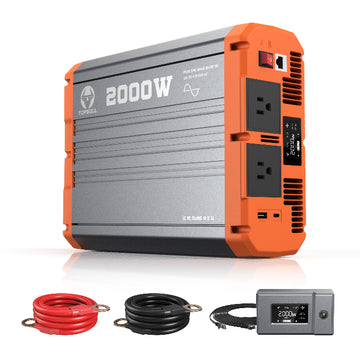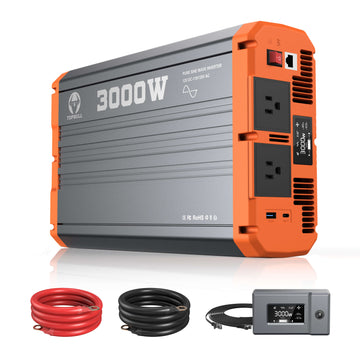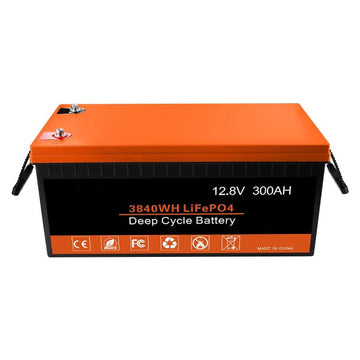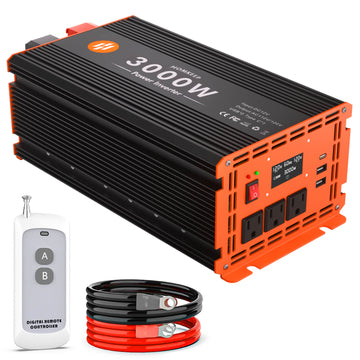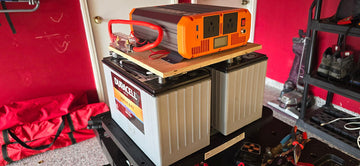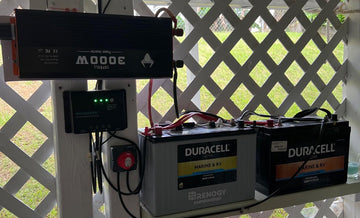Have you ever encountered such a situation: obviously installed solar panels or car inverter, but found that the power consumption does not decrease, but rather increase? The problem may lie in the “invisible power consumption” of the inverter - power loss. The inverter is like a “power mover”, converting direct current (DC) from batteries or solar panels into alternating current (AC) for home appliances, but this process is not a “lossless conversion”. Read about inverter losses to protect your wallet!
Concept of Inverter Power Loss
What is Inverter Power Loss? Simply put, power loss is the amount of electrical energy that cannot be efficiently utilized during the energy conversion process. For inverters, this loss usually occurs in several ways:
-
Switching Losses: The switching elements within the inverter generate heat during the switching on and off process, resulting in energy loss.
-
Conductor and connection losses: Heat is generated when current passes through a conductor, especially if the conductor is long or the current is high.
These power losses have a direct impact on the efficiency of the inverter, resulting in less energy being transferred to the appliance. All inverters have conversion efficiency, will not reach 100%, the general conversion efficiency of the inverter between 85%-98%, the lower the efficiency, the higher the loss!

The Impact of Inverter Power Losses
Power loss in inverters is not just an abstract technical concept, it has a real impact on the average consumer's daily life.
First of all, a reduction in inverter efficiency means that household appliances receive less energy, which can lead to a decrease in the efficiency of the equipment. If appliances are unable to obtain a stable power supply, they may suffer from poor performance and increased power consumption.
In addition, power loss can have an impact on your household electricity bill. Assuming that your inverter is less efficient, you will need to consume more power to achieve the required level of power in your home, and therefore your electricity bill expenses increase. This can lead to financial strain in the long run.
Finally, the power loss of the inverter may affect the lifespan of the device. An inefficient inverter may cause the device to overheat, which can shorten the life of the appliance.
How to choose a high-efficiency DC to AC inverter
Step 1: Lock the core index of “efficiency”
Recognize the efficiency value of the inverter:
When purchasing an inverter, focus on checking the inverter's “Maximum Conversion Efficiency” (usually between 90% and 98%).
High efficiency standard: ≥95% for home use, ≥90% for car/portable use.
Tip: Be wary of merchants who only mark “peak efficiency” and ask for “continuous efficiency” data.
Step 2: Match requirements by scenario
Domestic solar/energy storage system
Domestic scenarios require long-term driving of sensitive appliances such as fridges and air-conditioners, so waveform quality and efficiency stability are key.
-
Priority is given to pure sine wave inverters: their output waveforms are consistent with the utility power, ensuring low-noise and low-loss operation of motorized appliances.
-
Efficiency ≥95% is recommended: under high load (e.g. starting multiple appliances at the same time), it still maintains low heat generation and stable output.
- Additional features: If paired with a solar panel, it should be equipped with MPPT (Maximum Power Point Tracking) technology, which can improve solar charging efficiency by about 30%, and maximize the use of light energy in cloudy and rainy weather.
In-car/travel scenarios
In-car inverters need to take into account the portability and practicality, power matching and charging scalability are the core.
-
Modified sine wave can meet the demand: it is suitable for small appliances such as cell phones and laptops, and is more cost-effective.
-
Efficiency recommendation ≥ 90%: balancing performance and price, to avoid low efficiency of small power appliances due to the rapid depletion of the car battery.
- Recommended with USB fast charging port: support fast charging of cell phones, tablets and other devices, reduce the load pressure of simultaneous use of multiple devices.
Outdoor Emergency/Standby Power
Outdoor environments have stringent requirements for portability and standby power consumption of inverters.
-
Prioritize lightweight design: the case is sturdy and of moderate weight, easy to carry to the field or disaster areas.
-
Efficiency ≥85% is sufficient: due to the low frequency of use, a slightly lower efficiency will have less impact, but need to pay attention to the stability of the low load.
- Low standby power consumption (≤ 5W): long-term storage or occasional use, to avoid “invisible power consumption” to drain the battery.
Step 3: Avoid the three major “efficiency killers”
Heat dissipation design defects
For every 10℃ rise in internal temperature, the efficiency of the inverter may drop by 1%-2%. If the heat dissipation only relies on the passive aluminum shell, it is easy to trigger the overheat protection when the load is high, which leads to the sudden power failure of the appliance. It is recommended to choose models with intelligent temperature control fan or liquid cooling system, even if the long run can maintain low temperature and high efficiency.
The power labeling trap
Some merchants confuse “peak power” and “continuous power”. For example, the labeled 3000W inverter, the actual continuous output may be only 1500W, driving the air conditioner is easy to overload. Be sure to ask customer service to provide a third-party test report in the continuous power value, and give preference to brands certified by CE, FCC.
Standby power consumption black hole
Inefficient inverter standby power consumption of up to 10W or more, equivalent to 87 kWh a year (24 hours a day standby calculation). It is recommended to choose the model with standby power consumption ≤ 5W, and make a habit of turning off the power when not in use to avoid “ghost power consumption”.
High-efficiency DC to AC Inverter Recommendation
Topbull 2000W 12VDC to 120V/110V AC Inverter

Actual Efficiency Breakthrough: Continuous Output >90%
Authoritative Test Data: Third-party laboratory testing shows that the efficiency reaches 93.8% under 1600W load, and still exceeds 90% under full load of 2000W, which is far more than the industry standard (some brands only have 85% of the same power). The same power is only 85%).
Intuitive comparison of power saving: compared with ordinary 85% efficiency inverter, the annual electricity cost is about 420 RMB (calculated according to the average daily use of 6 hours, electricity price of 0.5 RMB).
No-load power consumption revolution: standby only 3W
- Ultra-low standby technology: the use of intelligent hibernation chip, standby power consumption is as low as 3W (similar products generally 5-10W), standby power consumption for the whole year is only 26 degrees, compared with the traditional models consume 40 degrees of electricity less.
- Scenario adaptation: as an emergency power supply for a long time when plugged in, almost no consumption of energy storage battery power, suitable for off-grid system or outdoor standby for a long time.
Waveform and stability double guarantee
- Pure sine wave output: measured harmonic distortion rate <3%, 60% reduction in noise of fridge, air conditioner and other motor-type equipment, extending the life of electrical appliances by 2-3 years.
- Five protection mechanisms: overload/overvoltage/short circuit/high temperature/reverse connection protection, measured with 1800W inductive loads (such as electric drills) without voltage drop, safety pull full.
Best use:
- Home PV energy storage system (with 12V battery pack)
- Outdoor mobile power (e.g. RV, camping)
- Backup power for small shops/workshops
Use a good inverter and master the 4 power saving tips
1. Power matching is key
When using an inverter, if you use a small load (e.g. 500W rice cooker) with a high power inverter (e.g. 3000W) for a long time, it will lead to a sharp drop in efficiency. This is because the inverter circuit cannot be optimized at low loads, and the loss may double. It is recommended to choose an inverter power that matches the total power of commonly used appliances by about 80%, e.g. for a total load of about 1600W, choose a 2000W inverter for the highest efficiency. If you need to bring more than one device, you can first calculate the peak power (e.g. air conditioner starting current is 3 times of the rated), and then reserve 20% redundancy. 2.
2. Reduce no-load standby and make it a habit to disconnect
The standby power consumption of the inverter may seem small (5-10W), but the long-term accumulation should not be ignored. If the inverter is on standby for 24 hours a day, the annual power consumption will be about 25-50 kWh. It is recommended to turn off the inverter power directly when not in use, or use the socket with a switch to disconnect the power. For PV energy storage users, you can set up the “timed start/stop” function, which will run automatically when there is enough light, and shut down automatically at night on standby.
3. Regularly clean the heat sink to improve efficiency.
If the inverter's heat sink is blocked by dust, the internal temperature may increase by more than 15℃, and the efficiency will decrease by 5%-10%. It is recommended to use a vacuum cleaner to clean the heat sink every month, and disassemble the machine to check the fan blades every quarter (power-off operation is required). For liquid-cooled models, the coolant can be replaced once a year to ensure efficient operation of the cooling system. 4.
4. Reject the “overload alarm” and reasonably allocate power consumption.
Starting multiple high-power appliances at the same time (e.g. microwave oven + kettle) is likely to trigger overload protection, and the inverter will force the power to drop, resulting in repeated restarting of appliances and a surge in power consumption. It is recommended to stagger the use of high-power devices, or upgrade the power of the inverter. For scenarios where simultaneous use is necessary (e.g. commercial kitchens), you can choose a model that supports “parallel expansion”, which allows you to connect multiple inverters in parallel to increase the load-carrying capacity.
FAQs about inverter
Q: Is it normal for the inverter to be hot?
A: Slight warmth is normal, but if the inverter is hot, you need to be alert. This may be caused by overload or poor heat dissipation. It is recommended to stop the machine to cool down in this case and check whether the connected electrical appliances exceed the rated power of the inverter.
Q: Why do different inverters consume different amounts of power for the same appliance?
A: This is mainly due to the difference in efficiency of the inverters and the quality of the output waveform. High-efficiency inverters (such as pure sine wave inverters) convert electricity with less power loss, but are more expensive. Repair sine wave inverters are usually cheaper, but the power loss may be greater when driving inductive loads (such as motors), so the same appliance may exhibit different power consumption on different inverters.
Q: Can a car inverter be used for appliances?
A: Careful use is required! Car inverters are usually designed to be used in 12V or 24V low voltage systems, and connecting them directly to 110V appliances may cause the device to burn out. Therefore, you need to make sure that the input voltage of the inverter matches the voltage of the appliance before use.
Q: How much power is lost by converting DC to AC?
A: There is a certain amount of energy loss during the conversion process of DC to AC inverters, usually, the efficiency of inverters is between 80% and 95%. This means that between 5% and 20% of the electrical energy may be lost during the conversion process, depending on the type and design of the inverter and the load.
Q: How efficient are DC to AC inverters?
A: The efficiency of a DC to AC inverter is usually the ratio between the output AC energy and the input DC energy. High-quality inverters may have conversion efficiencies approaching 95%, while low-quality inverters may have efficiencies of only about 80%. Choosing a high-efficiency inverter not only reduces power loss, but also saves your family money on their electric bill.
Conclusion
Understanding inverter power loss is important, not only to help consumers make more informed purchasing decisions, but also to effectively control household electricity bills. By choosing an efficient inverter and taking the proper energy saving measures, you can significantly improve the efficiency of your home energy use and lower your energy bills, thus creating a greener, more economical lifestyle. We hope this article has helped you to make your home energy use more efficient!

